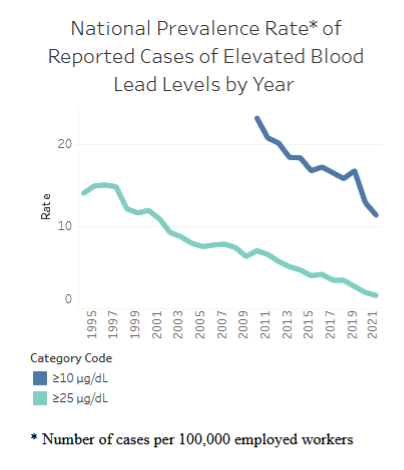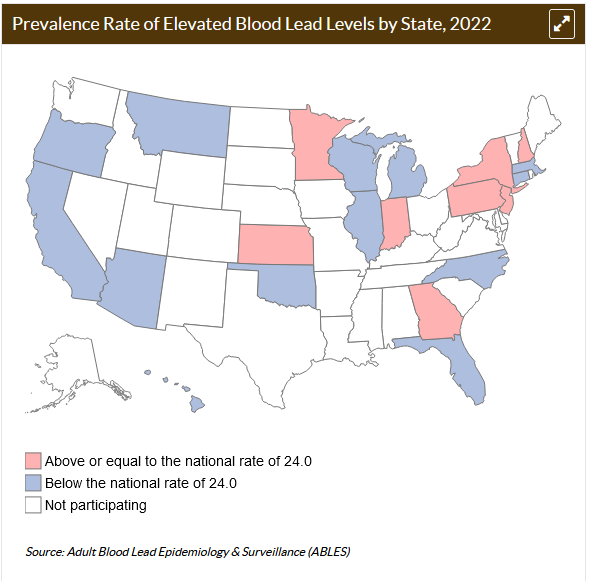What Happened
Last year, CalOSHA set a goal of reducing blood lead levels (BLLs) to less than 10 micrograms of lead per deciliter (µg/dL) for nearly all employees with occupational exposure to lead. Earlier this year, the agency took an important step towards that goal by significantly tightening its standards for construction operations (including renovation, repair, painting, demolition, and cleanup activities) and general industry (everything except construction and agricultural operations).1
The revised standard retains the decades old federal provisions that the requirements apply to ALL occupational exposure to lead from any source. If paint or coating is being disturbed, the rule applies whenever there is “any detectable concentration of lead” present, without regard to whether it meets EPA’s definition of lead-based paint.
The revisions, which go into effect January 1, 2025, include the following:
- Lowering the permissible exposure level (PEL) 5-fold, from 50 micrograms of lead per cubic meter (µg/m3) to 10 µg/m3 based on an 8-hour time-weighted average (TWA). For abrasive blasting in construction, the PEL drops to only 25 µg/m3 until 2030 with limitations on the practice.2
- Decreasing the action level 15-fold from 30 µg/m3 to 2 µg/m3 based on an 8-hour TWA. If workers may be exposed over the action level, before beginning the work, employers must provide them with air monitoring, personal protective equipment, and blood lead testing.
- Mandating use of “interim protections” for tasks that are presumed to exceed the PEL until the employer completes an exposure assessment and implements appropriate work practices. For construction, these are called “Trigger Tasks” and include common tasks include manual scraping, sanding, or demolition; cleaning, grinding or sanding with a power tool; or use of heat gun. For general industry, they are call “Presumed Significant Lead Work.” See end of blog for details on these tasks.
- Strengthening interim protections by requiring employers to provide washing facilities and ensure their workers use them for hands, exposed arms, and face before entering eating areas, drinking, smoking, or applying cosmetics, and at end of their shift. They must also receive personal protective equipment, medical surveillance, training and communication.
- Reducing BLLs that trigger an employee’s removal from the workplace for medical reasons.
Click here for the text of rule in track changes.
Why it Matters
In 1993, federal OSHA adopted worker protection standards for construction projects and updated the general industry standard. Over the past 30 years, those standards have been largely unchanged despite the increasingly clear scientific evidence that adults—not just young children—are at serious risk from even low levels of exposure to lead. No safe level in the blood has been identified for either group. See below for the latest evidence on lead risks to adults.

Based on CDC’s Adult Blood Lead Epidemiology Surveillance (ABLES) program and data from participating states, the U.S. made progress in reducing the prevalence of worker’s BLLs over 5 µg/dl and over 10 µg/dl from 2010 to 2020. Progress appears to have stalled starting in 2020. Keep in mind, the data is biased since the number of adults tested depends on employers complying with the blood lead testing requirements.3 In addition, compliance likely is lower in the construction industry where lead is common in paint and other construction materials.
Nonetheless, employers must do better. Based on the 2022 ABLES data, as many as 40,000 adults have a BLL over 5 µg/dl and 20,000 are over 10 µg/dl. California has much lower rates than the national average.
Our Take
Protecting workers from exposure to lead is important for their health as well as their ability to be productive. For that reason alone, we applaud CalOSHA for its improvements.
These improvements also will benefit the families of the workers who may take lead dust from their clothes and body home with them where it can spread to their children and partners. It likely is a greater problem for construction workers because they are on different worksites over the year and often eat in their personal vehicle at the residential job site.
We encourage federal OSHA and other states to consider revising their standards based on California’s model. In 2022, the agency asked for comments about potentially tightening the standards when workers had to be removed from work because of high BLLs. It needs to take this small step and then go much further to prevent workers’ exposure to lead rather than simply require greater action when someone is lead poisoned.
Finally, stronger standards are only a starting point. They have little impact if employers do not comply. In our experience, compliance with the lead standards is particularly low for the construction industry, especially residential jobs where worksites and workers move frequently, and there is less oversight. Employers and the regulatory agencies that oversee them must step up their efforts to ensure compliance to protect workers, their families, and their communities.
What are Lead Risks to Adults?
In 2012, the National Toxicology Program concluded “there is sufficient evidence that blood Pb levels <10 µg/dL and <5 µg/dL are associated with adverse health effects in children and adults.” For adults, it found there is sufficient evidence that BLLs:
- <5 µg/dL are associated with decreased renal function;
- <5 µg/dL in pregnant people are associated with reduced fetal growth;
- <10 µg/dL are associated with increased blood pressure and hypertension;
- <10 µg/dL are associated with increased spontaneous abortion and preterm birth; and
- <10 µg/dL are associated with essential tremors in adults.
Earlier this year, EPA reviewed the science from the past decade and found that lead exposure was causal—the highest level of evidence—for adult cognitive effects, cardiovascular effects and related mortality, renal effects, male reproductive effects and total nonaccidental mortality. It also quantified the societal benefits of reducing adult exposure to lead based on a lower risk of cardiovascular disease mortality.
What Tasks are Presumed to Exceed PELs?
For construction work, these tasks are called “Trigger Tasks” and include manual scraping, sanding, or demolition; cleaning, grinding, or sanding with a power tool; or use of a heat gun. The Trigger Tasks are assigned to Level 1, 2, or 3 with 3 being the riskiest tasks.
- Level 1 tasks are those likely to result in exposure between 1 and 10 times the PEL. Where lead-containing coatings or paint are present, they consist of “manual demolition of structures (e.g., dry wall), manual scraping, and heat gun applications.” In addition, they are any task that an employer “has any reasons to believe that an employee performing the task may be exposure to lead in excess of the PEL.”
- Level 2 tasks are those likely to result in exposures greater than 10 times the PEL. Where lead-containing coatings or paint are present, they consist of manual sanding; cleaning, grinding, and sanding WITH dust collection systems; and spray painting with lead paint.
- Level 3 tasks are likely to result in exposure between 50 times the PEL. They include use of lead-containing mortar. Where lead-containing coatings or paint are present, they consist of rivet busting; cleaning, grinding, or sanding with power tools WITHOUT dust collection system; cleanup activities where dry expendable abrasives are used; abrasive blasting; welding; torch cutting; and torch burning.
For general industry work, these tasks are called “Presumed Significant Lead Work.” They are those that alter or disturb material that is reasonably anticipated to be over 0.5% lead or involve torch cutting scrap metal.
- General industry standard applies to maintenance work at non-construction operations. ↩︎
- For abrasive blasting in construction, the PEL drops to only 25 µg/m3 until 2030. However, abrasive blasting is limited to a five hour workday, if using dry blasting media, until 2030, at which time the workday length drops to 2 hours. ↩︎
- These bias issues are also common with children’s blood lead testing where most communities test only a portion of those who should be tested. ↩︎

